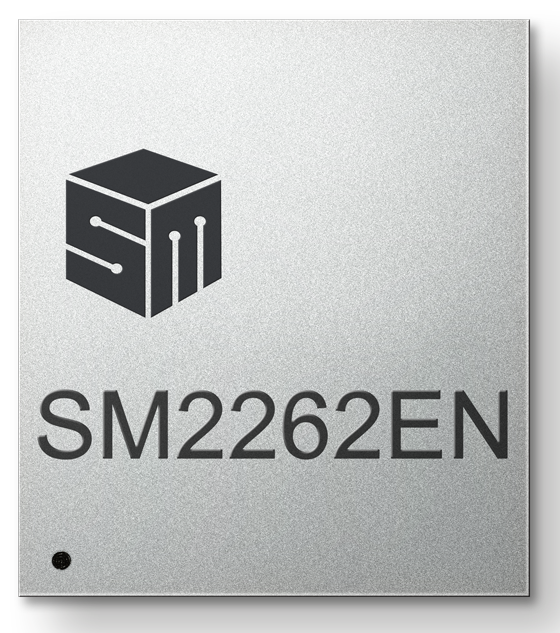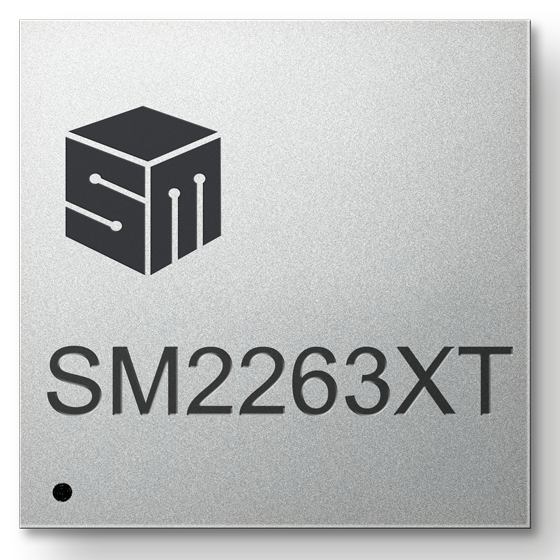Silicon Motion Has Four New 3D NVME SSD Controllers




Silicon Motion, Inc. displayed four new NVMe SSD controllers at Flash Memory Summit 2017. The company plans to have partner products with the new controllers on retails shelves in Q1 2018.
On the surface this is just another announcement of intent, but there is so much more to the story. Let's just get this out of the way first: The SMI SM2262EN will be in the fastest consumer SSD available when it's released next year. We spent time with a reference design paired with IMFT's new 256Gbit TLC flash, and it's the fastest product we've ever tested. The SM2262EN controller delivers enterprise-level sequential throughput performance.
There are two package designs. Above we see the lower-cost and smaller SM2263 with four channels and the ability to use a DRAM buffer on the PCB or, in the SM2263XT form, a DRAMless design that takes advantage of system memory to cache the table map using host memory buffer (HMB).
#PLACEHOLDER_#3
The image also shows the larger SM2262EN controller, which will also come in two options. The SM2262 will feed the upper mainstream market with a high-performance option. Were it available today, the SM2260 would be a competitor to Samsung's 960 series. That won't be good enough to compete for the performance crown in 2018, though. To combat Samsung's upcoming 970 and 980 series, SMI plans to work with partners to release the SM2262EN. The EN uses the same physical silicon but has different programming and firmware. The changes utilize new SMI IP that better optimizes the cache algorithms.
Just how fast is the SM2260EN, you ask? SMI's press release shows up to 3,500 MB/s sequential read and 3,000 MB/s sequential write. That's enough to match the fastest PCIe 3.0 x4 enterprise SSDs shipping today. It also delivers nearly 1,000 more MB/s of sequential write throughput than the Samsung 960 Pro.
| Controller | SM2263 | SM2263XT | SM2262 | SM2262EN |
|---|---|---|---|---|
| Host Interface | PCIe 3.0 x4 | PCIe 3.0 x4 | PCIe 3.0 x4 | PCIe 3.0 x4 |
| PCIe Protocol | NVMe 1.3 | NVMe 1.3 | NVMe 1.3 | NVMe 1.3 |
| NAND Flash Channels | 4 | 4 | 8 | 8 |
| CE/Channels | 4 | 4 | 4 | 4 |
| DRAM | Yes | No | Yes | yes |
| Host Memory Bufer | No | Yes | No | No |
| Sequential Read | 2,400 MB/s | 2,400 MB/s | 3,200 MB/s | 3,500 MB/s |
| Sequential Write | 1,700 MB/s | 1,700 MB's | 1,900 MB/s | 3,000 MB/s |
| Random Read | 300,000 IOPS | 280,000 IOPS (HMB)140,000 IOPS (No-HMB) | 370,000 IOPS | 370,000 IOPS |
| Random Write | 250,000 IOPS | 250,000 IOPS | 300,000 IOPS | 300,000 IOPS |
We've already shown the SM2262EN and know that it's going to be a driving force for SSD manufacturers. The SM2262 (non-EN) shouldn't be glossed over. This controller already produces 960 Pro-like performance as a working prototype.
Get Tom's Hardware's best news and in-depth reviews, straight to your inbox.
SMI didn't disclose the number of processor cores in each model, but we suspect the physically smaller SM2263 series features less processing power. This series most likely uses a dual-core processor, whereas the SM2262 uses a quad-core processor.
The SM2263 series splits into two distinct parts. The entry-level part is the SM2263XT DRAMless controller with up to 2,400 MB/s sequential read performance. The controller takes advantage of Host Memory Buffer (HBM) technology that's already built into your up-to-date Windows 10 installation. HMB uses up to 38MB of your system's memory (DRAM) to cache the data map table. There is a latency penalty with this technology, but it's much less than you would expect. SMI chose to show only the random read numbers with and without HMB.
The SM2263 will cover the mainstream SSD market with up to 2,400 MB/s sequential read performance. The controller, when paired with the right 3D NAND flash, will deliver 20,000 more random read performance than the SM2262XT using HMB technology and 160,000 more without HMB.
At Flash Memory Summit 2017, we learned that Intel removed the 610p from the SSD roadmap and will replace it with a new 700-Series part that will in turn replace the aging SSD 750. It looks like Intel and SMI's other partners will have several options to choose from, and the new entry-level standard will increase nearly 2x in real-world performance. 2018 looks to be a strong year for consumer SSD performance.

Chris Ramseyer was a senior contributing editor for Tom's Hardware. He tested and reviewed consumer storage.
-
AgentLozen This news sounds really promising. I like hearing about competition in the market.Reply
Apparently, it's really really hard to build SSD controllers that keep up with Samsung controllers judging by all the reviews that come through Tomshardware. When I hear that Silicon Motion is designing a Samsung killer, it's hard to believe. It would be great if that were the case though. -
AcesB Awesome new device! Good to have competition! But it is still slower than system using RAM disk cache utility, as SuperCache, PrimoCache, etc. You can also use a ordinary SSD drive as L2 level cache, to enlarge cache size. When coupled to a few gigabytes of RAM as L1 cache, you have I/O throughput around 8000 MB/s and cache hit above 80%.Reply

